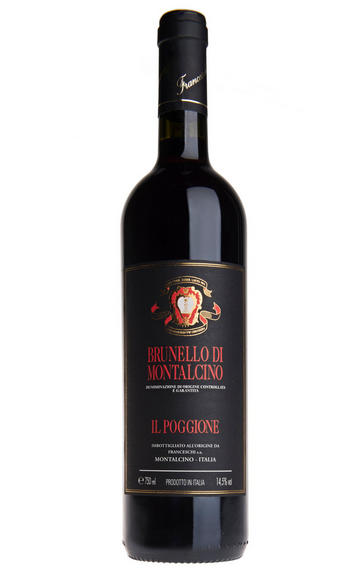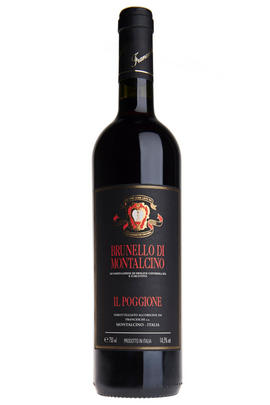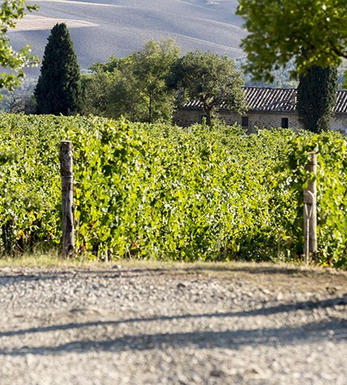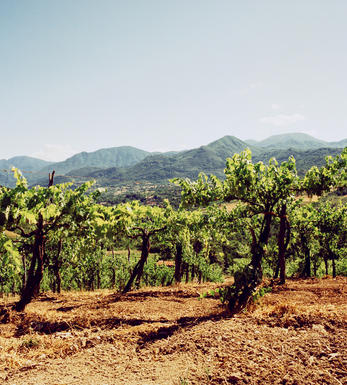
2016 Brunello di Montalcino, Il Poggione, Tuscany, Italy

Critics reviews
A classic from the first tilt of the glass, the 2016 Brunello di Montalcino wows the senses with a pleasantly old-school bouquet of leather, earth tones, dried flowers, crushed cherries, sage and clove. This mixes radiant dark red fruits with sweet spices and salty mineral tones to create a display of contrasts, all over a silky textural wave that’s guided by vibrant acidity. Youthfully tense yet spicy with an orange flourish and amazingly fresh, the 2016 finishes with a tart tinge of youthful tension and fine-grained tannins that will require patience to resolve. This is, without a doubt, one of the vintage's top wines. The 2016 is total class.
Drink 2026 - 2042
Eric Guido, Vinous (November 2023)
I’m not sure how Il Poggione manages to remain one of the largest producers of Brunello, maintaining such a high level of quality and turning out some of the best wines of the vintage year after year - but they do. The 2016 Brunello di Montalcino is yet another stunning example. Depths of mineral-encased black cherries, sage, allspice, licorice, tobacco and crushed violets lift up from the glass. It’s seamlessly silky, even as the palate is peppered with tart red and black berries, nervous acids and savory exotic spices. This shows the density and weight of the vintage in a youthfully monolithic stance, yet with all the necessary components to maintain perfect balance. The 2016 Il Poggione seems to fold in upon itself through the finish, which is dark, mysterious and structured, with only hints of black tea and licorice to tempt the imagination. It’s a classic in the making.
Drink 2026 - 2040
Eric Guido, Vinous (November 2020)
Lustrous ruby. Savoury, meaty and brooding. Still quite closed. With aeration stony minerally notes emerge. Bags of sour-cherry and raspberry fruit in perfect balance with the finely chiselled tannins. Mouth-watering, long and focused.
Drink 2022 - 2038
Walter Speller, JancisRobinson.com (March 2021)
The Il Poggione 2016 Brunello di Montalcino opens to a medium dark appearance with pretty Sangiovese shine and a little ruby sparkle. This vintage shows a slightly untamed or wild side with a dense and heavier fruit profile. The focus here is on blackberry, dried cherry, tobacco and even a touch of smoky tobacco or horse saddle. The wine shows the firm grip and tannic backbone that is a common trait in this vintage, especially with the vineyards on this southern, sunlit side of the appellation. I also get a considerable flash of acidity on the close, almost too much, that certainly needs a few more years to soften. You really need to wait with this one. Production is an ample 200,000 bottles.
Drink 2024 - 2044
Monica Larner, Wine Advocate (November 2020)
A red with blackberry, cherry, some walnut and chocolate, as well as mahogany. Tea, too. It’s full-bodied and firm-tannined with beautiful length and depth. Linear and very fine. Drink after 2024.
James Suckling, JamesSuckling.com (November 2020)
Among Montalcino's largest estates, Il Poggione continues to impress in 2016 under father and son winemaking duo, Fabrizio and Alessandro Bindocci. The wine wears its warm, southwestern origins assuredly on its sleeve, exhibiting dark bramble fruit intertwined with baked thyme and rosemary, fragrant wet earth and leather. It is weighty but not weighed down, and sports the grip and zip of the vintage, the lingering finish full of tobacco and spice.
Drink 2024 - 2040
Michaela Morris, Decanter (March 2021)
About this WINE

Il Poggione
Il Poggione is a winery steeped in history with its origins dating back to the late 1800s. Owned by Leopoldo and Livia Franceschi , it is situated below the beautiful hilltop town of Sant’Angelo in Colle, a part of the Brunello di Montalcino appellation characterised by temperate, yet well-ventilated micro-climate. This benefits the grapes by maintaining refreshing acidity levels and extending their ripening time.
Father and son winemaking team Fabrizio and Alessandro Bindocci coax the best from these privileged vineyard sites; they are also proponents of a traditional wine-making style which includes submerging the cap with frequent pump overs (for more colour and tannin extraction), and ageing in large casks (so that wood flavours remain subtle and do not interfere with the natural expression of the Sangiovese and the Sant’Angelo terroir).
The Riserva bottling, made in the finest vintages, receives at least one year extra ageing in French oak casks. The typical style is intense, full-bodied, powerful, packed with dark fruit, menthol, sweet smoke, cocoa and spice flavours and a hint of earthiness.
In the best vintages the wines demonstrate extraordinary development in bottle. Even better, prices have remained very reasonable, considering the superb quality of the wine. Poggione’s straight Brunello is one of the most fairly-priced, cellar worthy wines of the appellation.
This is a benchmark property for fine, traditionally made Brunellos capable of ageing superbly.

Brunello di Montalcino
Along with Chianti, Brunello di Montalcino is Tuscany's most famous DOCG and the region's boldest expression of Sangiovese. Located 30 miles south of Siena with the hilltop town of Montalcino as its epicentre, its 2,000 hectares of vines are naturally delimited by the Orcia, Asso and Ombrone valleys. Brunello is the local name for the Sangiovese Grosso clone from which Brunello di Montalcino should be made in purezza (ie 100 percent).
The Brunello di Montalcino DOCG has a whale-like shape: at its head, at 661 metres above sea level on ancient, stony galestro soils facing east and southeast lies the town of Montalcino, where the DOC was founded. As you follow the spine south towards the tail, the vineyards lose altitude – those around Colle Sant'Angelo are at 250 metres – while the soils become richer with iron and clay. Further east, in the shadow of the 1,734 metre Mont'Amiata lies the village of Castelnuovo dell'Abate where the vineyards are strewn with a rich mix of galestro, granitic, volcanic, clay and schist soil types.
Historically, the zone is one of Tuscany's youngest. First praised in 1550 by Leandro Alberti for the quality of its wines, it was Tenuta Il Greppo who bottled the inaugural Brunello di Montalcino in 1888. By 1929, the region had 925 hectares of vines and 1,243 hectares of mixed crops, while in 1932 it was decreed that only those wines made and bottled within the commune could be labelled as Brunello di Montalcino. Since then, the number of producers has risen from 11 in 1960 to 230 in 2006, while over the same period the vineyards have expanded from 1,000 hectares to 12,000. The region earned its DOC in 1966, and was upgraded to DOCG in 1980.
Brunello di Montalcino cannot be released for sale until five years after the harvest, or six years in the case of Brunello di Montalcino Riserva. During this time the wines should be aged for at least two years in oak, followed by at least four months in bottle (six months for Riservas); maximum yields are 55 hl/ha.
Rosso di Montalcino is declassified Brunello di Montalcino, released for sale 18 months after the harvest.
Recommended producers: Costanti, Fuligni, Lisini, San Giuseppe, Soldera, Cerbaiona

Sangiovese
A black grape widely grown in Central Italy and the main component of Chianti and Vino Nobile di Montepulciano as well as being the sole permitted grape for the famed Brunello di Montalcino.
It is a high yielding, late ripening grape that performs best on well-drained calcareous soils on south-facing hillsides. For years it was blighted by poor clonal selection and massive overcropping - however since the 1980s the quality of Sangiovese-based wines has rocketed upwards and they are now some of the most sought after in the world.
It produces wines with pronounced tannins and acidity, though not always with great depth of colour, and its character can vary from farmyard/leather nuances through to essence of red cherries and plums. In the 1960s the advent of Super Tuscans saw bottlings of 100% Sangiovese wines, as well as the introduction of Sangiovese/Cabernet Sauvignon blends, the most famous being Tignanello.


Buying options
Add to wishlist
Description
Classic Brunello notes on the nose of dark cherries, spice and beef on a butcher’s block. A pure joy on the palate, rich and palate-filling with notes of black cherries and dark berry notes, coupled with grilled meats, cocoa powder and undergrowth notes. The savoury fruit is balanced by rapier-like acidity and plenty of finely-grained tannins. Serious and profound, unusually for Il Poggione, this will need a year or two in the cellar before it will be showing its best. Drink 2022-2040+.
Chris Pollington, Private Account Manager
wine at a glance
Delivery and quality guarantee